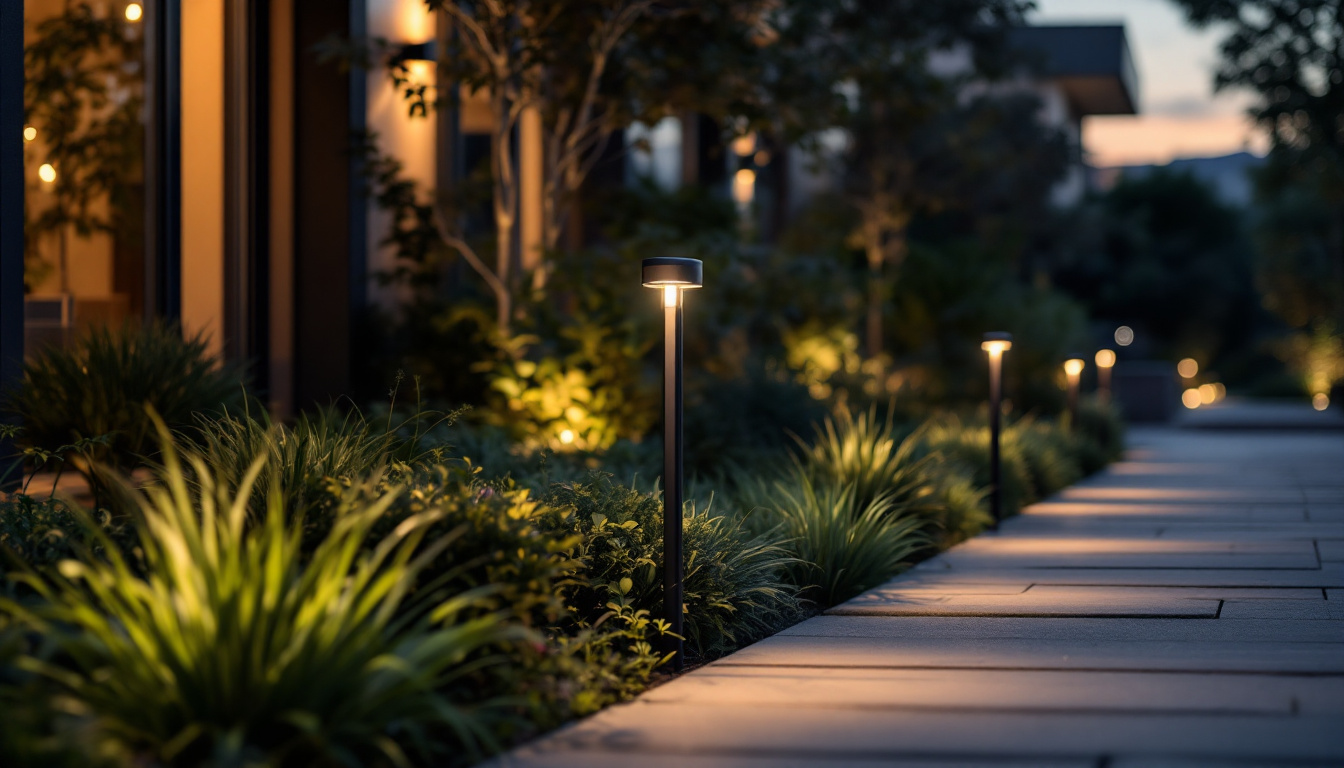
In recent years, the outdoor lighting industry has undergone a significant transformation, particularly with the advent of sensor lights. These innovative lighting solutions have not only enhanced the functionality of outdoor spaces but have also contributed to energy efficiency and improved security. For lighting contractors, understanding the evolution of sensor lights is crucial for staying ahead in a competitive market.
Sensor technology has been around for some time, but its application in outdoor lighting has evolved dramatically. Initially, motion sensors were primarily used in security systems, providing a basic level of detection. However, advancements in technology have allowed these sensors to become more sophisticated, leading to the development of a variety of sensor lights that cater to different needs.
Early motion sensors operated on simple principles, detecting movement within a certain range and triggering lights accordingly. While effective, these systems often had limitations, such as false triggers from animals or environmental factors. Today, smart sensors utilize advanced algorithms and artificial intelligence, allowing for more accurate detection and response. This evolution has led to the creation of lights that can differentiate between people, pets, and objects, significantly reducing false alarms.
Moreover, these smart sensors can adapt to their environment, adjusting sensitivity based on the time of day or weather conditions. For example, during heavy rain or snowfall, the sensors can recalibrate to avoid unnecessary activation, thus conserving energy and extending the lifespan of the lighting system. This adaptability not only enhances functionality but also contributes to a more sustainable approach to outdoor lighting, aligning with the growing emphasis on eco-friendly technologies.
The integration of sensor lights with home automation systems has further revolutionized outdoor lighting. Contractors can now offer clients solutions that not only illuminate outdoor spaces but also enhance overall home security and convenience. For instance, sensor lights can be programmed to interact with security cameras, alarms, and even smart doorbells, creating a comprehensive security network. This integration has become a selling point for many homeowners, making it essential for contractors to stay informed about these technologies.
In addition to security benefits, the integration of sensor technology with home automation can lead to increased energy efficiency. Homeowners can set schedules and control lighting remotely through smartphone applications, allowing them to turn lights on or off based on their needs. This level of control not only provides peace of mind when away from home but also helps in managing energy consumption, ultimately reducing utility bills. As the demand for smart home solutions continues to grow, the role of sensor technology in outdoor lighting will likely expand, offering even more innovative features and functionalities that cater to modern lifestyles.
The advantages of sensor lights extend beyond mere convenience. They offer numerous benefits that appeal to both homeowners and contractors alike. Understanding these benefits can help contractors make informed recommendations to their clients.
One of the most significant advantages of sensor lights is their energy efficiency. Traditional outdoor lighting systems often operate continuously, leading to wasted energy and higher utility bills. In contrast, sensor lights activate only when needed, significantly reducing energy consumption. This feature is particularly appealing to environmentally conscious homeowners looking to minimize their carbon footprint. Additionally, many modern sensor lights are equipped with LED technology, which not only enhances energy savings but also boasts a longer lifespan compared to traditional bulbs. This means fewer replacements and less waste, further contributing to a sustainable lifestyle.
Security is a primary concern for many homeowners, and sensor lights play a vital role in enhancing safety. By illuminating pathways, driveways, and entry points when motion is detected, these lights deter potential intruders and provide peace of mind. For contractors, highlighting the security benefits of sensor lights can be a persuasive selling point, especially in neighborhoods with higher crime rates. Furthermore, the presence of these lights can create a safer environment for family members and guests, reducing the risk of accidents in poorly lit areas. Some advanced models even come with integrated cameras or alarms, providing an additional layer of security and allowing homeowners to monitor their property remotely through smartphone applications.
Another noteworthy benefit of sensor lights is the convenience they offer. Homeowners no longer need to fumble for switches in the dark or worry about leaving lights on during the day. With adjustable settings, many sensor lights allow users to customize the sensitivity and duration of illumination, catering to individual preferences and specific needs. This level of customization can be particularly advantageous for families with children or pets, as it ensures that the lights activate only when necessary, without causing unnecessary distractions or disturbances. Additionally, some sensor lights can be integrated with smart home systems, enabling users to control their outdoor lighting remotely or set schedules for enhanced convenience.
As the lighting industry has evolved, so too has the design of sensor lights. Gone are the days of bulky, unattractive fixtures. Today’s sensor lights come in a variety of styles and finishes, allowing homeowners to choose options that complement their outdoor aesthetics.
From sleek modern designs to more traditional looks, the variety of sensor lights available allows for greater flexibility in outdoor design. Contractors can now offer clients a range of options, ensuring that the chosen lighting not only serves its functional purpose but also enhances the overall appearance of the property. This adaptability is essential in meeting the diverse tastes of homeowners.
Many modern sensor lights come equipped with smart features that allow for customization and control via mobile apps. Homeowners can adjust brightness levels, set schedules, and even change the color of the lights to suit different occasions. For contractors, being knowledgeable about these features can provide an edge in consultations, as clients are increasingly looking for customizable solutions.
While sensor lights offer numerous benefits, proper installation is crucial to ensure optimal performance. Lighting contractors must be aware of various factors that can impact the effectiveness of these systems.
The placement of sensor lights is critical for maximizing their functionality. Contractors should consider factors such as the detection range of the sensors, potential obstructions, and the specific areas that require illumination. For instance, lights installed too close to walls may not detect motion effectively, while those placed in open areas may be triggered unnecessarily by passing animals.
Another important consideration is the wiring and power sources for sensor lights. While many options are available, including hardwired and solar-powered systems, contractors must evaluate the specific needs of the installation site. Solar-powered lights offer flexibility and ease of installation, but they may not provide adequate illumination in shaded areas. Conversely, hardwired systems can deliver consistent performance but require more extensive installation work.
Despite the many advantages of sensor lights, there are challenges that contractors may encounter during installation and maintenance. Understanding these challenges and how to address them is essential for successful project execution.
One of the most common issues with sensor lights is false triggers. These can occur due to environmental factors such as wind, rain, or passing animals. To mitigate this, contractors should recommend models with adjustable sensitivity settings, allowing homeowners to customize their lights based on their specific environment. Additionally, positioning the sensors away from areas prone to disturbances can help reduce false activations.
Like any outdoor fixture, sensor lights require regular maintenance to ensure optimal performance. Contractors should educate homeowners on the importance of keeping sensors clean and free from obstructions, such as leaves or debris. Regular checks can help identify any issues early on, preventing costly repairs or replacements down the line.
The future of sensor lights looks promising, with ongoing advancements in technology and design. As the demand for energy-efficient and smart home solutions continues to grow, the outdoor lighting industry will likely see further innovations that enhance functionality and aesthetics.
As sustainability becomes a priority for many homeowners, the integration of sensor lights with renewable energy sources, such as solar panels, is expected to increase. This trend not only aligns with environmental goals but also offers homeowners a cost-effective solution for outdoor lighting. Contractors should stay informed about these developments to provide clients with the most up-to-date options.
The rise of the Internet of Things (IoT) has paved the way for increased connectivity in outdoor lighting systems. Future sensor lights may feature enhanced connectivity options, allowing them to communicate with other smart devices in the home. This interconnectedness could lead to more sophisticated lighting solutions that adapt to the homeowner’s lifestyle, further enhancing convenience and security.
The evolution of sensor lights in the outdoor lighting industry has transformed the way homeowners approach illumination, security, and energy efficiency. For lighting contractors, understanding the advancements in sensor technology, design, and installation considerations is essential for meeting the needs of modern clients. As the industry continues to evolve, staying informed about the latest trends and innovations will ensure that contractors remain competitive and can provide the best solutions for their customers.
By embracing the benefits of sensor lights and addressing the challenges associated with their installation and maintenance, contractors can enhance their service offerings and contribute to a more sustainable and secure future for outdoor spaces.
Ready to elevate your lighting projects with the latest sensor lights? At LumenWholesale, we provide lighting contractors with the highest quality, specification-grade lighting products at unbeatable wholesale prices. Say goodbye to local distributor markups and hello to superior lighting solutions that meet the highest industry standards. With our extensive selection, you’ll find the perfect sensor lights to meet the evolving demands of your clients, ensuring energy efficiency, enhanced security, and impeccable design. Plus, with free shipping on bulk orders, you get the best value without any hidden fees. Don’t compromise on quality or cost. Wholesale Lighting at the Best Value is just a click away. Experience the LumenWholesale difference today!

Discover the ultimate guide for lighting contractors on LED light cans.

Discover essential tips and strategies for lighting contractors to prevent common pitfalls in connector lighting projects.

Discover the transformative power of B Type bulbs in lighting design.

Discover the essentials of motion detector recessed lights with our comprehensive guide tailored for lighting contractors.